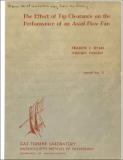| dc.contributor.author | Ryan, Francis J. (Francis James) | en_US |
| dc.contributor.author | Ōhashi, Hiroshi | en_US |
| dc.contributor.other | Massachusetts Institute of Technology. Gas Turbine Laboratory | en_US |
| dc.date.accessioned | 2016-10-06T21:22:05Z | |
| dc.date.available | 2016-10-06T21:22:05Z | |
| dc.date.issued | 1955 | en_US |
| dc.identifier.uri | http://hdl.handle.net/1721.1/104707 | |
| dc.description | May 1955 | en_US |
| dc.description | AT head of title: Three-dimensional flow in turbo-machine research | en_US |
| dc.description | Includes bibliographical references (page 18) | en_US |
| dc.description.abstract | The effect of tip clearance on the performance of a single stage axial flow (6000 cfm) fan was investigated for tip clearances ranging from 0.003 in. to 0.252 in. It was found that, at the rated flow, the stagnation pressure rise (mass flow weighted) across the fan rotor was a maximum for the smallest tip clearance and a minimum for the largest tip clearance. However, it was found also that at the rated flow, the stagnation pressure rise was larger at a tip clearance of 0.022 in. than at a tip clearance of 0.015 in. At a flow of 4000 cfm (two thirds of rated flow) the effect of tip clearance was found to be negligible over the entire range of clearances tested. At flows in excess of 6500 cfm, the stagnation pressure rise was highest for a tip clearance of 0.022 in. Plotting a performance map of stagnation pressure rise across the rotor versus volume flow also revealed that as the peak pressures became higher, these peaks shifted to lower values of flow. This would indicate a shifting of the surge line vertically and horizontally on the performance map as the tip clearance is varied. The flow pattern in the original fan, as manufactured, was investigated also. This revealed that, at the rated flow, the suction sides of the stator blades were stalled over approximately the after one-half of their surface while the pressure sides were completely unstalled. This study also showed that, at all flows tested, the flow pattern at the rotor tip was somewhat turbulent, while the pattern at the rotor root was stable at high flows but became very unstable at low flows. At flows below 000 cfm reversal of flow started near the rotor tip. | en_US |
| dc.description.sponsorship | Under the sponsorship of: General Electric Company, Westinghouse Electric Corporation, Curtiss -Wright Corporation and Allison Division of the General Motors Corporation | en_US |
| dc.format.extent | [33] pages in various pagings (some unnumbered) | en_US |
| dc.publisher | Cambridge, Mass. : Gas Turbine Laboratory, Massachusetts Institute of Technology, [1955] | en_US |
| dc.relation.ispartofseries | GTL report #31 | en_US |
| dc.subject.lcc | TJ778.M41 G24 no.31 | en_US |
| dc.subject.lcsh | Rotors | en_US |
| dc.subject.lcsh | Fans (Machinery) | en_US |
| dc.title | The effect of tip clearance on an axial flow fan | en_US |
| dc.title.alternative | Three-dimensional flow in turbo-machine research | en_US |
| dc.type | Technical Report | en_US |
| dc.identifier.oclc | 14191578 | en_US |
